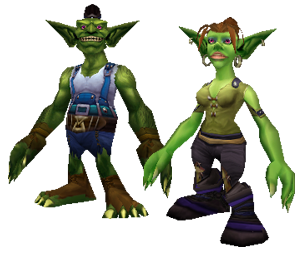This article or section needs to be cleaned up to conform to copyright laws and fair use.
|
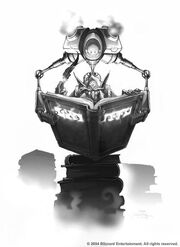
Goblins are small, green (or yellow-green) creatures with pointy features and high intelligence (though often little common sense).
A number of trade princes rule over the various goblin holdings around the world. Though the trade princes all live in the goblin city of Undermine on the Isle of Kezan, they each control their own private armies and trade fleets. In turn, each controls rings of trade, mining, deforestation, slave rings, and poaching.
Overview
Goblins are small humanoids, crafty and shrewd, bearing an overwhelming interest in commerce and a strong curiosity about mechanical things. Goblin society is fragmented, defined chiefly by commerce and trade. The ultimate schemers and con artists, goblins are always in search of a better deal. Despite their seemingly chaotic natures, they exist in a fairly strict and straightforward hierarchy. Other races universally view goblins as inventors, merchants and, without exception, maniacs. Goblins value technology as a useful aspect of commerce. Some say that their advantage — and their curse — is to be the primary users of technology in a world governed by magic. While dwarves and gnomes share a similar gift, goblin technology is more far-reaching and sinister and makes a larger impact on the natural world.
They employ vast teams of engineers who expand on current technology and produce gadgets to suit a wide array of applications. They constantly build and repair machines and work on new ideas. Unfortunately, goblins alternate passionate genius with wandering focus. Their lack of discipline means that many creations end up half finished as something else catches their attention. Goblin workmanship has a partially deserved reputation for unreliability, and a goblin device may explode simply because its creator forgot to add a vital release valve. Goblins are envious of the Ironforge dwarves’ invention of firearms, both from a commercial and a technological standpoint. Goblins recognize that firearms represent a new source of power, and he who controls the source controls the gold — which is, to goblins, the ultimate power. Fortunately for the rest of the world, goblin firearm experimentation suffers from the race’s normal laxity — and improperly tended gunpowder experiments continue to end the careers of many aspiring goblin tinkers. However, goblin ingenuity has paid off a few times; goblin gunpowder weapons tend to be inelegant and violently explosive (land mines, rockets and the like).
A number of trade princes rule over Azeroth’s various goblin holdings. Though the trade princes all live in the goblin island city of Undermine far from Kalimdor and the eastern continents, each controls his own private army and trade fleet. Each trade prince has his own specialty, monopolizing trade in a certain area, such as mining, deforestation, slavery or poaching. The trade princes are the most cunning of their race and stop at nothing to amass their fortunes and power, whether through legitimate means or via black markets and treachery. Goblins encountered on Kalimdor and the eastern continents are freelancers, privateers or agents of Undermine’s trade princes. Goblins are tenacious fighters. They attack from range with crossbows or firearms (making individual modifications to dwarf-made weapons) and use maces, short swords or bizarre, home-brewed steam weaponry in melee. When attacked in their warrens, they fight with tools as well. Goblins have a good grasp of tactics and strategy, and are masters of siege warfare. Their love of large machines makes them ideal mercenaries for attacking fortifications.
Goblins are shrewd in business, and clients who believe they walked away with the upper hand are almost always sorely mistaken. “To cheat a goblin” is a dwarven idiom meaning “to do what is practically impossible.” (“Gamgi cheated a goblin when he escaped that cave-in!”) Goblins are also consummate tricksters and con artists. Their mission in the world is to create incredible new inventions, accrue the resulting wealth, and cause as much subtle mischief as possible along the way.[1] (WoWRPG 41-42)
Old friends, the goblins fought with the Horde in the Second War, but broke off when they realized that it’s more profitable to work both sides. However, many goblins remember the fun of the Horde and are willing to lower mercenary prices to Thrall and his people. Goblins offer almost exclusive transport services for the Horde, whether in their steamboats or zeppelins. You’re more likely to find a team of goblin sappers, who take great pleasure in the chaos the Horde creates, meshed into Horde forces than those of the Alliance. Perhaps with enough persuasion, the goblins could be convinced to rejoin the Horde for the first time since the Second War (although that could be just as harmful as helpful, knowing the goblins).[3] (HPG 188, 190)
History
First Appearances
Goblins first appeared in Warcraft II published by Blizzard Entertainment in December 1995, and have appeared or been referenced in many sources since.
Their earliest appearance chronologically was in War of the Ancients trilogy; Neltharion created the Demon Soul before the War of the Ancients with the help of goblin artificers — hinting that the goblins may be an ancient race.
Early history
Goblins have been around for a long time, but the creatures were reclusive. Long ago, the goblins were a native race of the Isle of Kezan, and didn’t have a fraction of their current intelligence. There, the race lived as slaves to the jungle trolls, mining the subterranean tunnels where the trolls didn’t like going. However, soon the goblins unearthed a mineral known as kaja'mite (a strange mineral named after Mount Kajaro). The trolls valued the mineral, using it in voodoo rituals, and forced the subterranean goblins to continue mining the mineral. The goblins soon came to sense at some basic level that the mineral held enchantments unknown to the trolls. The goblins hoarded the mineral, using it to fashion crude objects of power deep within Undermine’s twisting tunnels. However, the mineral had some unexpected side effects, it causes the goblins to grow in intelligence. Soon, goblins developed technology, if just crude weapons and armor.
With their increased intelligence, goblin cunning rose, and soon the race enacted a plan to free themselves from the trolls. In little time, the goblins owned the Isle of Kezan, and declared Undermine their capital. Goblins rapidly expanded their knowledge of technology. Goblins created Azeroth’s first steam technologies. Rumors are that goblin technology back then was far more advanced than current dwarven technology. Goblins established themselves as master technicians, selling their goods on the open market. However, the power within the kaja’mite artifacts were finite, and soon dwindled, needing to be replaced. Eventually, kaja'mite ran out altogether. Desperate, goblins spread out into the world, attempting to find any pockets of kaja’mite they might have missed. Unfortunately, over the next few thousand years, up until roughly five hundred years before the First War, the goblins could find no further deposits of kaja’mite and goblin intelligence peaked. Without kaja'mite to strengthen their minds, goblins were unable to reproduce their brilliant technology or properly maintain it, and their works rapidly devolved into the crude juryrigged machines of today. The world began to fear the volatile machines, and sales dropped considerably. Goblins always had a love of money, however. With the loss of their intelligence and slow degradation of their technology, goblins embraced commerce. About two hundred years before the First War, the beginnings of Trade Fleets sailed out of Kezan and into the world.[2] (DF 114)
First and Second Wars
Goblins chose war as the perfect opportunity to cash in some gold, and began building their trade empire during the First War.[2] (DF 114) For examples they sold dirtworms to the Horde to tunnel under Alliance defenses.[4] (MoM #?) By the Second War, the goblins had established themselves as the traders of the world. Then, they became exclusive partners with the Horde. A Horde ambassador ventured forth and met with a single trade prince (rumored to be the Steamwheedle Cartel[3] (HPG 188), perhaps Trade Prince Steamwheedle), asking for the goblins to provide machines and technology to the orcs, in exchange for spoils and gold. In the beginning, the arrangement seemed perfect. The goblin trade prince believed that the orcs would win the war, so he found it natural to join the winning side. As the profits flooded Undermine’s coffers, the goblins expanded their slave markets. However, other goblins disagreed and remained neutral; thus, only this single trade prince and his subordinates joined the Horde. In the end, the trade prince realized his mistake and left the Horde, and the goblin race remembers the mistake and remains neutral to this day. The goblin race as a whole, in fact, is neutral. They discovered it was more profitable to play both sides against each other.[2] (DF 114, 115)[5] (BtDP 94)
Culture
Technology
- See also: Goblins versus gnomes
Though once nothing but fodder for more taproom banter, goblin inventions have shown their worth in recent years. They're particularly fond of tinkering with mechanical things, alchemy, and explosives. Their love of mechanics often places them into direct competition with gnomes who enjoy similar devices. Whether clockwork "shredders" that allow a single goblin to do as much harvesting as 10 field hands or zeppelin-like "airships" that can ferry troops over otherwise impassable terrain, the goblins' inventions have become legendary. Such technological ingenuity is as central to the goblins' rise among the races as any trading prowess.
Even with the malfunctions and explosions that occur (not as frequent as tavern chatter suggests, but far from rare), goblin technology is proving to be of a quality that rivals the dwarves and their firearms. If they possessed physical strength and mystic power to match their inventiveness and cunning, they would be a force of some significance. Of course, the goblins claim that they are already - if not for their frail physical forms, goblins would rule the world. Then they laugh and say they prefer a challenge and offer to buy the taproom guests the next round.
Role in the Second and Third War
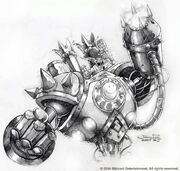
Goblins came to dubious fame in the Second War for the suicide missions they undertook for the Horde, strapping explosives to themselves and floating behind enemy lines with the aid of an inflated sheep's bladder. In the aftermath of conflict, the goblins established that they had no political orientation. Their only real interest was trade: if you had the coin for their goods, they were your friends. Such neutrality gives them as broad a trading basis as possible for their wares, from magic items to mundane goods to their own mechanical inventions. It is rumored that they joined during the Second War either because the orcs paid or intimidated them.
On the whole, the Alliance and the Horde respect the goblins' new power, taking advantage of the trade princes' ability to produce or procure otherwise difficult-to-acquire items. Rumors have emerged of goblins engaging in massive strip mining and deforestation operations to harvest the raw materials, however, which cause the nature-loving night elves and tauren great concern. Since the tales have surfaced, the trade princes have suffered guerrilla attacks on their supply trains and sabotage of their factories. The goblins are clever enough to know the list of suspects is a short one, and they appear undaunted by the threat. They have amassed enough wealth to hire additional security for their mercantile concerns.
Trade
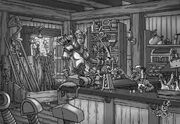
A Goblin Shop
At some point after the Second War, the goblins apparently grew tired of carrying explosives for the Horde and decided that they needed to take control of their own destinies. Surprisingly, they proved smart enough to know that building an army of their own would be an even bloodier choice for their race than sapping and planting mines. So they chose a different path.
The goblins have taken to the role of merchant with a vengeance, and now it’s hard to travel for more than a day or two without stumbling across a goblin shop of some size. Goblin zeppelins fly across the continent, delivering goods, supplies, messages and passengers from one shop to another, and I’ve heard more than one goblin brag that if it isn’t in his shop, he can have it on the shelves within a week. One joker challenged that claim and ordered a dozen shredders, only to find them waiting outside his cottage two days later.
Goblin shops can be found nearly anywhere on Azeroth, seemingly regardless of whether or not there are towns nearby and heedless of dangers such as the Scourge. The goblins will sell anything to anyone, at only slightly inflated prices.
Apparently, the proprietor of each goblin shop determines how to protect his business from theft. Some of the solutions employed include the hiring of mercenary fighters as security guards; complicated, tinker-built security systems; and, most notoriously, enormous bombs on a dead man’s switch that can be detonated on a moment’s notice if a goblin merchant feels threatened. After news spread of thieves and bullies entering shops that were replaced moments later by smoking craters, few have found the nerve to probe how a given shop might be protected.
Though many shops remain independent, a growing number of them have signs declaring that they are owned and operated by the “Venture Company,” which the proprietors claim is headquartered in a faraway city ruled by goblins where the streets are paved with gold.[6] (LoC 28-29)
The goblins are also legendary for the sheer variety of trade in which they are willing to indulge and for their tenacity in bargaining. Goblins rarely let an item slip from their shelves for a single copper less than it is worth. The industrious goblins have established shacks and minor trading towns across much of Kalimdor in an impressively brief span of time. These outposts may vary in size and location, but all have a similarly impressive array of goods. The outposts get regular supply shipments (or as regular as possible, given the hazards of travel across Kalimdor), all coordinated by the goblin trade princes.
The trade princes are the most cunning of their race and will stop at nothing to amass their fortunes and power, whether through legitimate means or via black markets and treachery. Goblins encountered on Kalimdor or the Eastern Kingdoms are either privateers or agents of the various trade princes of Undermine.
Goblins are not purely mercenary. They are known to form strong bonds with individuals of other races. Their small forms and odd behavior make other races - elves in particular - ill at ease, but goblins do not seem to care much for the impression they make. They judge by deeds, befriending those who treat them as friends and standing apart from those who would offer them abuse.
Breeding
According to the comment made by one of Warcraft RPG developers[citation needed] (and Gaxim Rustfizzle), goblins "breed like rabbits", which accounts for them quickly outnumbering and, eventually, destroying any other races in areas they settle in.
Such is the case with Tanaris, where goblins outnumber native Sandfury Trolls, as well as the Isle of Kezan, where they also pushed the native trolls out of the majority of the land. The only reason that the goblins don't outmatch the Horde and the Alliance in population is because goblins often blow themselves up.
Cooking
Several Goblins are also renown for their skills as chefs. Cooking recipes such as Goblin Deviled Clams and Undermine Clam Chowder are a staple of the trade pioneered by the spindly green race. Adventurers in Azeroth wishing to advance their skill in the culinary arts to the Artisan level are directed to assist Dirge Quikcleave, the master chef of Gadgetzan, in his creation of the succulent new dish, Clamlette Surprise. Another renown Goblin chef, Legassi, who is stranded in Hellfire Peninsula after a zeppelin crash, directs players in the creation of several new tantalizing dishes as well.
Faith
Goblins place their faith in themselves and in gold. They raise eyebrows at insubstantial concepts such as shamanism and the Holy Light, preferring gods they can see, weigh and spend.[1] (WoWRPG 42)
Languages
- For main article, see Goblin (language).
Goblins speak Goblin, orcish, and Common. Goblins know myriad languages in order to trade with as many races as possible.[1] (WoWRPG 43)
Military Tactics and Forces
Goblin Forces Goblin armies are terrifying to behold. The Trade Fleets are outfi tted with the most fanatical and destructive creatures on Azeroth. The average person wonders why the trade princes require such powerful armies, if they are holding to their neutrality stance. It certainly seems excessive.
The simple truth is, the forces are not excessive. The life of those living on the South Seas is harsh, due to attacks from everything from pirates to rogue magical beasts. Conflict exists everywhere, and a trade prince is always in peril of death. Every day, a trade prince must test his food on three different people. There is only one way to become a trade prince, and that’s to take out the competition. Thus, to prevent rivals from taking their thrones and to ensure that business may be conducted as normal, each trade prince enlists a hefty force of warriors. It’s absolutely necessary to keep order in the goblin world.
The Trade Fleets also require extreme guards. Undermine’s goods sail everywhere, especially into hostile or desolate territories to make a coin. Simply put, goblins go to dangerous places. Without strong guards, there would be no trade, because there would be only dead traders.
Despite appearances, goblins maintain rigid procedures and formations for battle. They only look disorganized. Goblins are intelligent, and they use their brains in battle. Confuse the enemy, and the enemy leaves blind spots. Slip in between the cracks and break the forces open from the inside. Many battles during the Second War were lost when Alliance forces underestimated goblin tactics.[2] (DF 178)
Not surprisingly, all goblin forces use a wide and dizzying array of technological weaponry. From the simplest fi rearms to the largest steam-driven war instruments, goblin technology dominates war fi elds. Even magic has a difficult time creating as much destruction and havoc as goblin war machines.
When goblins fought in the Second War, they created three units especially for the war effort. Goblin zeppelins rode high above the terrain to scout out the area, and occasionally transported warriors. Goblins also lent their services as sappers, using explosives to take out enemy fortifications. Often the goblins went with the explosives, but this was of little consequence. Sappers were a copper a dozen.
Furthermore, during the war, goblins fought from all angles, especially the sea. The Stormreaver clan captured giant sea turtles native to the southern seas. Pacified by potent spells of control, these lumbering monstrosities were fi tted with watertight canopies strapped onto the backs of their shells and used as submersible orcish craft. By submerging under the waves, the giant turtles could steal upon unsuspecting enemy craft and report their position to the Horde fl eet. They were visible solely to towers, creatures of the air, and other submersible vessels. The daring goblins who controlled them were dedicated to destroying enemy ships by launching hazardous, steam-driven canisters containing highly volatile liquids that shredded even the strongest armor.
During the Third War, goblins also fielded shredders to anyone who paid well enough. The pilots cared little about the actual war, preferring to chop down forests for their pay. However, when push came to shove, goblin shredders proved lethal in battle. The pilot’s inexperience with battle was evened out by the shredder’s armor and powerful steamsaw, which cut down enemies as easily as trees. Goblins hired themselves to anyone with the gold, and alongside shredders, the goblins fielded sappers and zeppelins once again in battle. Even tinkers and alchemists joined the fight, granting explosive and chemical warfare to the highest bidder.[2] (DF 179)
Notable goblins
Appearance
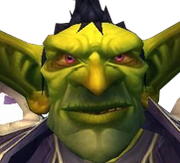
Male goblin's face
Goblins are slight and wiry, averaging 3 feet in height and weighing between 30 and 50 pounds. They have long, sharp noses, chins and ears, and green skin. Their arms are long and slender and their fingers deft. They tend to wear leather clothing, often cut into aprons to protect against caustic fluids. Goggles usually cover their eyes, and various technological devices are strapped across their bodies.[1] (WoWRPG 42) Goblins that have hair often have it as mohawks, ponytails or spiky.
Relations
Goblins are a wily, cunning race of traders and tinkers whom adventurers typically encounter as parts of trading envoys… or on pirate raids. Goblin ships frequent the seas, ferrying or seeking riches, slaves or exotic wares. Kalimdor’s main goblin port is the party town of Ratchet, a harbor city located on the eastern shore of the Barrens directly between Durotar and Theramore. Goblin trade outposts are found everywhere, including all major cities and such inhospitable realms as Northrend and Stranglethorn Vale. Their zeppelins run a wealthy business ferrying passengers across kingdoms and continents.[1] (WoWRPG 42) Goblins tolerate carrying armed passengers in their zeppelins, however, they don't transport cannons or heavy artillery in their zeppelins becuase that could compromise their neutrailty[7].
Goblins are neutral and take pains to make sure their nearby customers play nice with each other. Goblin guards patrol Ratchet and a few of the other goblin settlements, keeping tabs on the various Horde and Alliance visitors. Despite these enforcers however, the goblins' neutral settlements can still be dangerous places, as members of either faction will often still attack each other in the belief that they can evade the guards. With the exception of Ratchet, their settlements generally have a consistent appearance and construction.
Traveling goblin merchants employ bodyguards to protect them and their wares. Goblins are independent. Goblins hired themselves out to the Horde in the Second War, but now they belong only to themselves and whoever pays them. Constantly building and inventing requires massive resources, both for creating the machines themselves and maintaining those that actually work. Cannibalizing old machines only partially sustains this fervent activity of creation, so goblins rely on trade with as many races and cultures as possible. They are the quintessential merchants, peddling all manner of exotic goods for the highest possible prices.

A goblin from the Warcraft II manual
Goblin mechanical and mercantile pursuits are not always (or even often) performed within the bounds of polite society. Though not evil, goblins are willing to embark on shady business ventures — slavery, deforestation, poaching, smuggling and oil drilling, for example — to accomplish their goals. They are opportunists to the core and revel in bartering the better deal at every turn. Goblins try to get along with all other races. Doing so is part of their business. Nevertheless, everyone views goblins with justified suspicion. Night elves in particular dislike the goblins because the little creatures have no respect for nature or natural resources.[1] (WoWRPG 42)
Goblins are a capitalistic bunch and most buy or sell anything to make a profit. Goblin merchants love to haggle, have excellent wares and are too smart to be cheated — or so they claim. Most big cities have at least one stationary goblin merchant shop, managed by a goblin family. The heads of the family run the shop while the younger goblins travel the land to find, buy or steal the inventory. They sell to anyone: Alliance, Horde or Independent. Some even deal with demons if the price is right. Some goblins drive their carts from town to town, buying and selling as they go. These carts look rickety and secondhand, but the appearance is likely a diversion. A goblin’s cart is usually in perfect driving condition; the goblin never knows when he may have to leave town quickly or outrun an enraged customer. These merchants are often less than reputable and more likely to have items that they cannot identify themselves. Goblin merchant houses are not necessarily places to avoid, however. Often a hero can discover hard-to-find items, even rare or magic items, within the walls. As long as the hero is able to spot a bad deal, it should be safe for him to enter.
The goblins are an unbending bunch, refusing any sort of barter and demanding to be paid only in gold. There is a saying around Ratchet: If a traveling goblin merchant were starving to death and someone offered to trade food for the goblin’s merchandise, he’d starve before he accepted anything but gold. A customer who enters a goblin shop intending to barter finds himself laughed out into the street. The goblins do not even allow their employees to receive discounts or work for merchandise. Goblins deal only in gold. The merchants accept gold in any form and have precise scales to aid their customers. Goblins accept recently mined nuggets, panned dust or defaced Alliance gold coins that would be refused in other areas. They are grumpier about accepting silver, but do so.[1] (WoWRPG 177)
Horde and Alliance
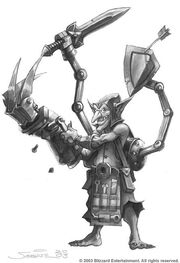
The goblins care little for the Alliance and Horde conflicts; what concerns them, as usual, is the effect these events have on their cash flow. The goblins do not, as a rule, like the Scourge, as the undead threatened to wipe out the entire populations of the Alliance and Horde, leaving the goblins with no customers. War is profitable for the goblins; annihilation is not. Once they served as suicide mercenaries for the Horde; now the goblins have made their place as the strongest merchant race in the world. If one wants to purchase something, whether it is supplies, equipment, weapons, magic items or even slaves, the goblins either have it or know where to get it. All that matters is the price, in their eyes..
The goblins like a balance of power. Military conflicts make money for the goblins as the combatants purchase supplies, and if the two sides are evenly matched, conflicts could go on for generations. This promises fat purse bags for the goblins for years to come. The goblins helped out the Horde for years because of this, but now they feel the Horde has come to match the Alliance in power, and they rest in the neutral middle, satisfied to play mercenary and merchant to either side.
The goblins understand the Alliance better than they understand the neutral races, as they have a long history of dealings with the Alliance. As merchants, they are frequently found in Theramore, and as mercenaries, they may even be found among the Alliance armies. True business entrepreneurs, goblins understand their customers very well and almost always know what they want. Their favorite Alliance customers are the high elves, who jump at the chance to buy magical items.[8] (A&HC 70, 71) Although many in the Alliance consider the goblin mercenaries to be war profiteers, they are not above using them. If they have no tinkers, or their tinkers have died in a previous battle, they sometimes have to go to the goblins for repairs or supplies. And the goblins are always ready to help a customer, for the right price.[9] (APG 181)The goblins’ skills certainly don’t stop at trade. Although not as talented at the invention of firearms as the Ironforge dwarves, the goblins have refined their inventing talents to create a handful of very useful tools that are, of course, for sale. Since the latest conflicts, the goblins have modified their marketing tactics to focus on pushing their deforestation operations to the night elves, of all races, to help clear out the cursed Felwood Forest. They also sell their zeppelins to the night elves, so that these customers can spot and put an end to deforestation. They made a great deal of money selling items to help the Alliance fight Illidan and his army of blood elves and naga, and constantly remind the Alliance members who travel through Ratchet that Illidan is still out there and supplies are always needed. Some merchants are able to mask the tone of glee in their voices while saying this, but most don’t bother.[8] (A&HC 70, 71)
The Horde and the goblins get along fairly well, as the orcs remember the (well-paid) sacrifice of the goblins for their cause in earlier wars. They still purchase zeppelins and other goblin services. The goblins often enjoy the company of the orcs, and the war veterans from both races will get together and drink if offered the opportunity.[8] (A&HC 70, 71) Old friends, the Goblins fought with the Horde in the Second War, but broke off when they realized that it’s more profitable to work both sides. However, many goblins remember the fun of the Horde and are willing to lower mercenary prices to Thrall and his people. Goblins offer almost exclusive transport services for the Horde, whether in their steamboats or zeppelins. You’re more likely to find a team of goblin sappers, who take great pleasure in the chaos the Horde creates, meshed into Horde forces than those of the Alliance. Perhaps with enough persuasion, the goblins could be convinced to rejoin the Horde for the first time since the Second War (although that could be just as harmful as helpful, knowing the goblins).[3] (HPG 188, 190)
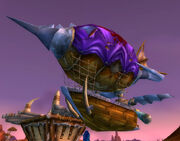
A goblin zeppelin
Perhaps the only remaining goblin scruple is that they will not betray a customer. While they understand each side of the war very well, if the Alliance is paying them for services, merchant or mercenaries, they will not act as double agents for the Horde. This is as close to honor as the goblins usually get.[8] (A&HC 70, 71)
Goblins don't like gnomes much, as they are the two races that are best at engineering. They often combat in engineering, like at the Mirage Raceway in Shimmering Flats. It's hard to said who is the best at engineering, goblins or gnomes.
Allegiance
There appear to be some goblins still working with the Horde found in Ashenvale, Orgrimmar, Camp Mojache and Thousand Needles; even then, goblins working for the Horde run the zeppelin system. Some goblins are a part of the Warsong offensive, a few even displaying the Horde symbol on their tabard. [1] [2] Also, there are a handful that seem to be in the pay of the Alliance, such as the SI:7 agent Renzik "The Shiv". However, the RPG says these are mercenaries or merchants making money off the Alliance or the Horde to work for them, or by selling stuff to them.
Other Goblin Types
- Hobgoblin
- Coal Goblin
- Spider-Eye Goblin
Trivia
- In World of Warcraft, Goblins borrow the basic skeleton from dwarves, although their profile photo is at a different angle; they also possess a unique dance and other different animations. The older goblin model used for shredder pilots and flight masters takes the basic skeleton from imps.
- Some goblin NPC names have a second meaning, out of context with the game environment. As a <Fashion Designer>, the goblin Haughty Modiste's name is constructed of the words haughty, a form of disdainful arrogance, and modiste, a French word that means "fashion designer" or "fashion vendor". Likewise, Snurk Bucksquick <Zeppelin Master> talks openly about escorting the player's character to the steamy jungles of Stranglethorn Vale, to "show [them] a real jungle cat.".
- Female goblins for some reason use the male gnome sounds in combat - although there aren't many female goblin npcs that you can fight, all you need to do is go at war with one of the goblin factions and fight one in order to hear it.
- A goblin is an evil, crabby, or mischievous creature of folklore (mainly European, but other mythologies have similar creatures), often described as a grotesquely disfigured or gnome-like phantom, that may range in height from that of a dwarf to that of a human.
- Before Patch 2.3.0, goblins could not wear (or at least show) Head items. Kiz Coilspanner was the first to show this, followed by the helmed Irradiated Workers' models being switched from gnomes to goblins.
References
| ||||||||||||||||||||||||||||||||||||
